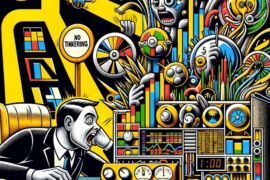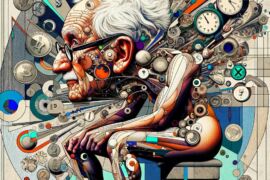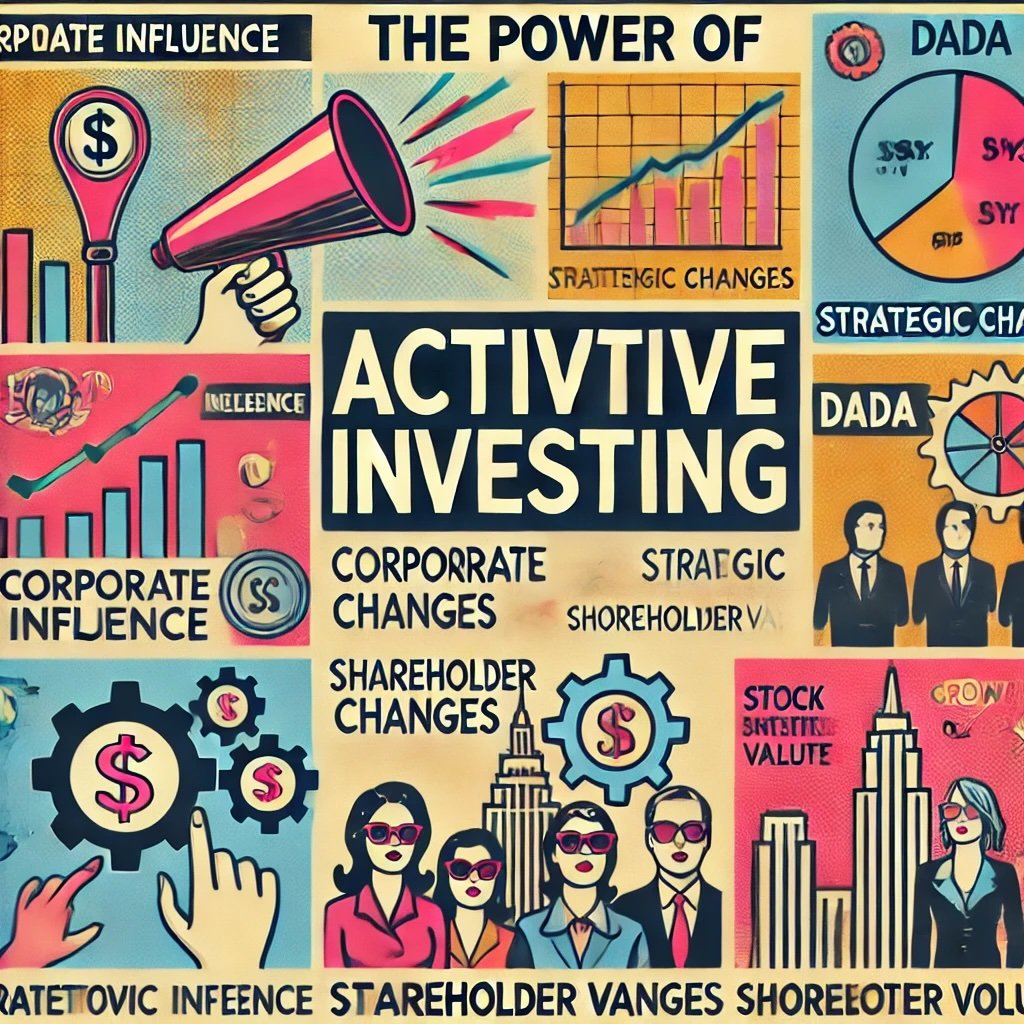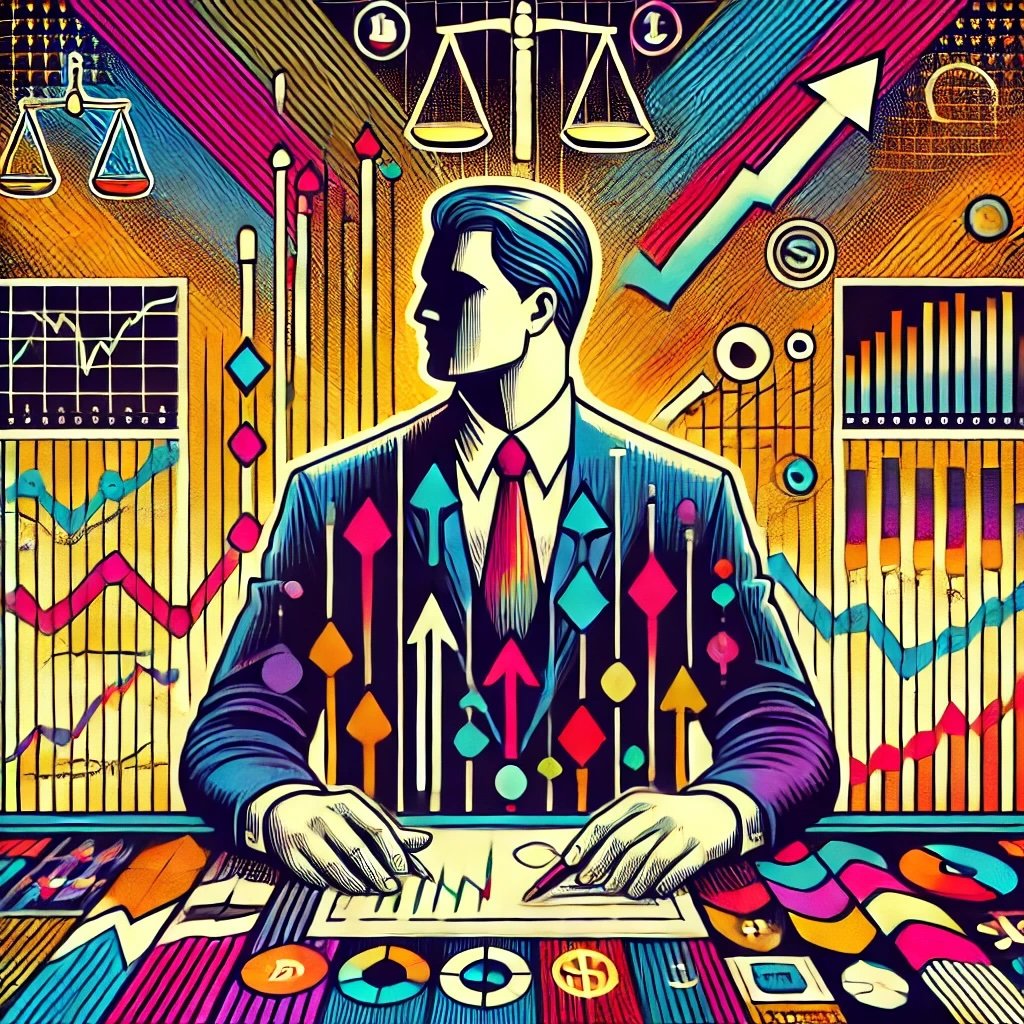For centuries, the world of art collection was largely limited to physical pieces—paintings, sculptures, and other tangible forms that might hang in private homes, galleries, or museums. Owning art implied you physically possessed an object that could be touched (albeit carefully) and displayed in a physical space for all to see. The mediums ranged from oils on canvas to intricate tapestries, each representing a particular era, style, or cultural narrative. Throughout history, this notion of “traditional artwork” has remained central to how people collect and appreciate artistic expression, forming a backbone for everything from major auction houses to personal art studios.

Art was tangible, and that was that.
However, a revolutionary twist emerged in the early 21st century with the digital age. The rise of blockchain technology paved the way for non-fungible tokens, better known by their abbreviation: NFTs. An NFT is essentially a digital certificate of authenticity and ownership recorded on a blockchain, enabling unique identification of digital assets. Suddenly, “digital art” wasn’t just an easily copied file floating on the web. Instead, it could be tokenized into a singular, verifiable piece of property—a concept that shook up how collectors thought about owning intangible creative works.
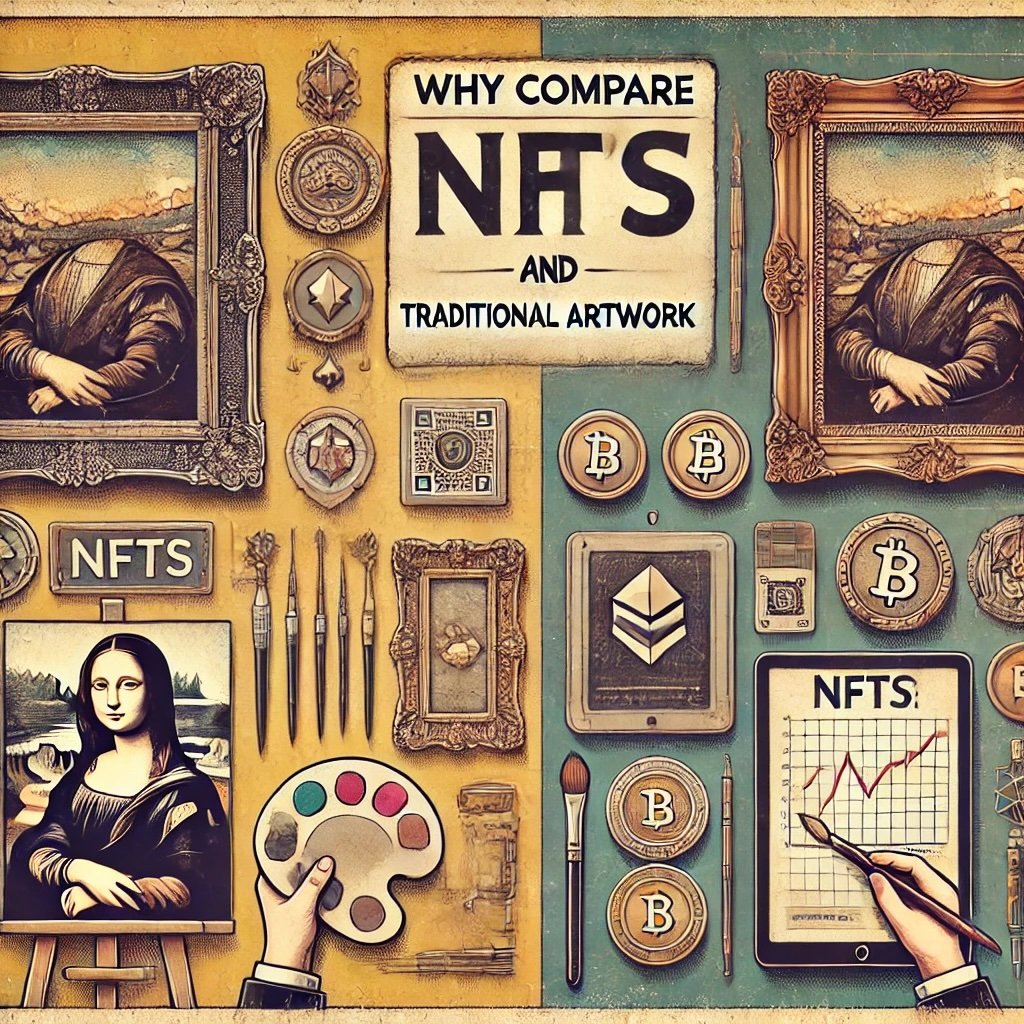
Why Compare NFTs and Traditional Artwork?
At first glance, comparing physical paintings by Renaissance masters to minted digital tokens might sound absurd. After all, how can intangible data stored on a blockchain match the centuries-old tradition of holding a real painting in your hands? Yet, as the NFT market exploded, with some pieces fetching millions of dollars, a wave of questions flooded the art and collectible communities:
- Are NFTs truly “art,” or just hype?
- Does the intangible nature of an NFT undercut the sense of value that physical art commands?
- Will digital ownership or new creative forms overshadow the old, or can both coexist in a broadening art landscape?
Such questions and more illustrate the significance of pitting these mediums side by side. Because in many ways, NFTs and traditional art each embody different ends of the art-collecting spectrum—one anchored in centuries of physical culture, the other emerging from cutting-edge digital innovation. By juxtaposing them, we gain fresh insight into how technology, creativity, and markets evolve—and what that means for collectors, artists, investors, or casual admirers of both forms.
Change compels us to reevaluate timeless norms.
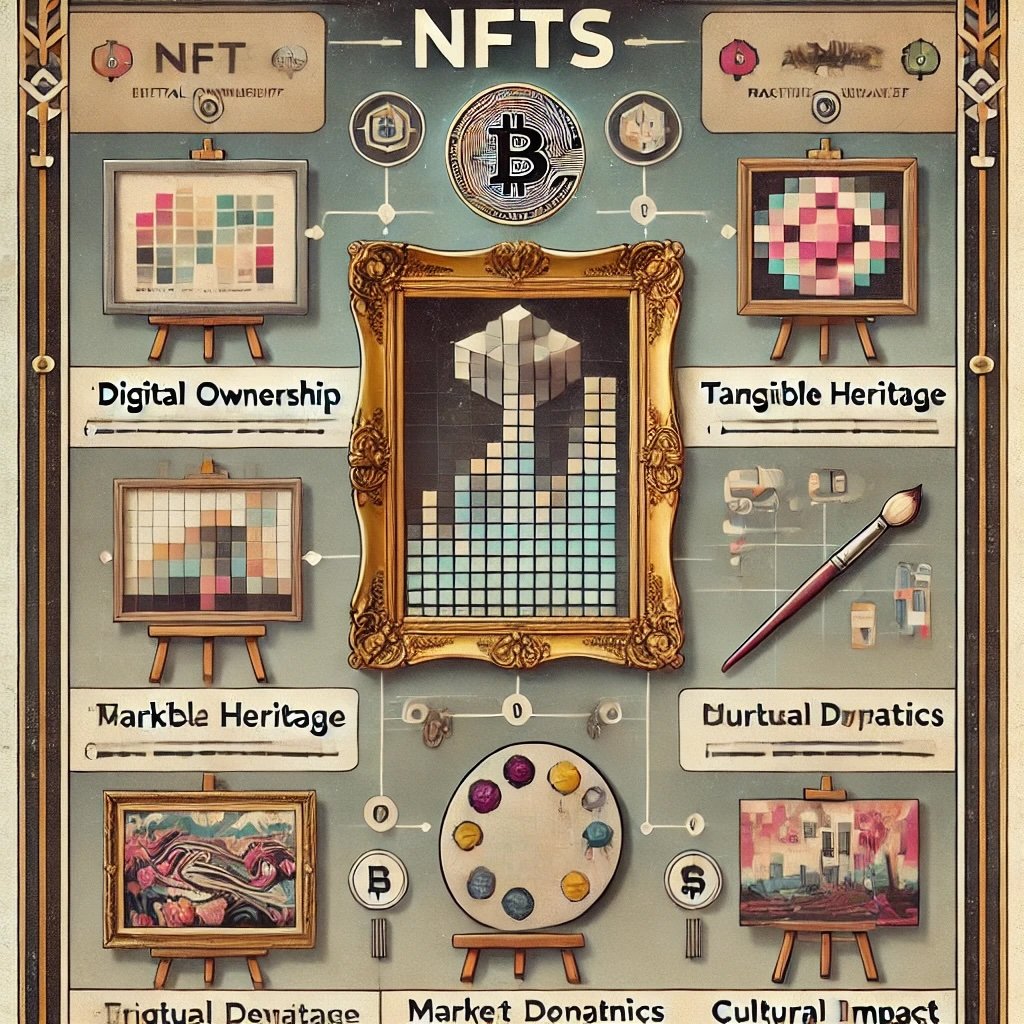
Unique Features Of NFTs and Traditional Artworks
In this blog post, we’ll dissect the key aspects that define and differentiate NFTs and traditional artworks, exploring their unique features, market dynamics, valuation principles, and the inherent risks plus benefits in each domain. We’ll also peer into the future, considering how these two realms might converge or further diverge as collectors become more sophisticated in their tastes and as technology continues reshaping creative expression. Through this comparison, readers should be able to develop a clearer perspective on:
- How NFTs brought digital ownership to the forefront.
- Why traditional art’s tangible nature and deep cultural roots still carry weight.
- What to watch out for—fraud, speculation, or shifting tastes—if you decide to invest in or collect either type of art.
Both mediums can serve as conduits for artistic genius, personal fulfillment, or financial speculation, so understanding them thoroughly paves the way for smarter decisions, whether you’re a long-time collector or a curious newcomer.
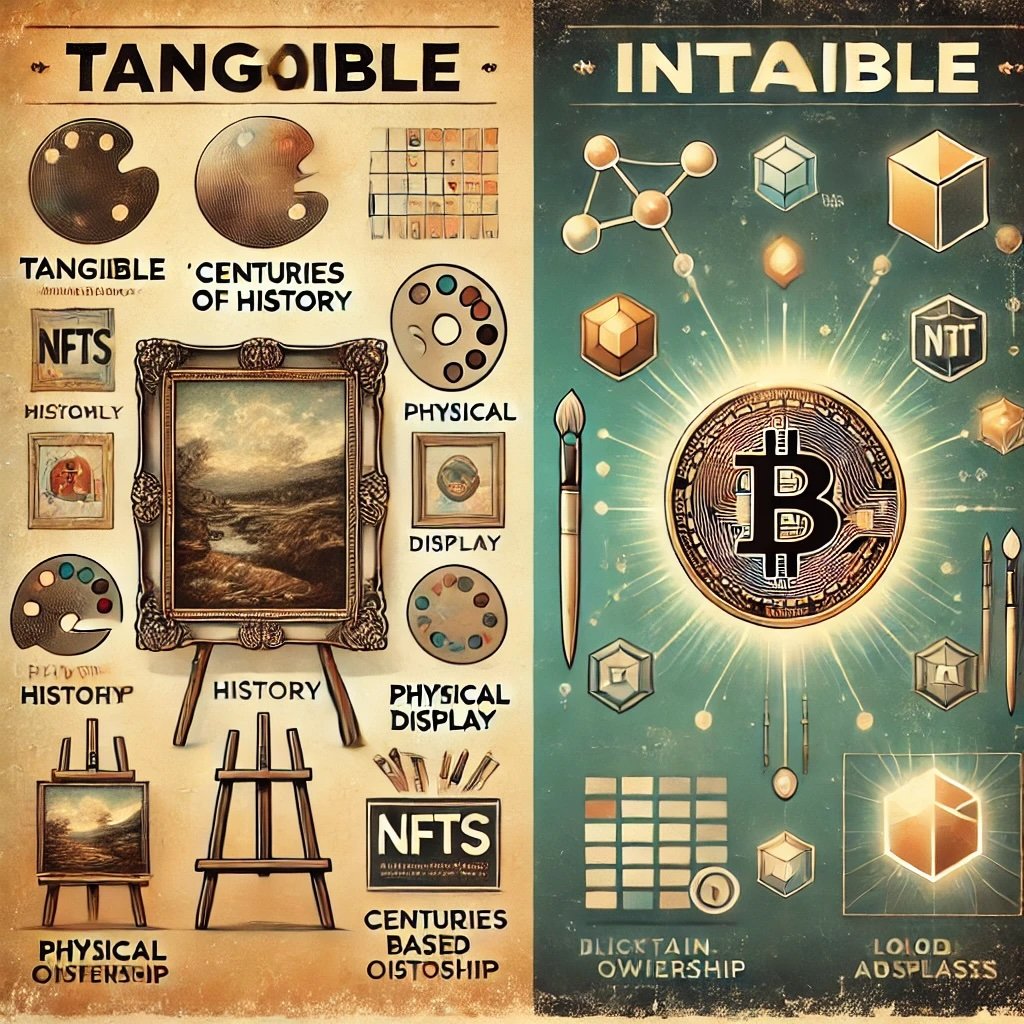
Key Features of NFTs and Traditional Artwork
In evaluating NFTs against traditional artwork, the conversation quickly splits along tangible vs. intangible lines. Traditional paintings, sculptures, and other forms exist physically in the real world. NFTs, however, are purely digital tokens recorded on a blockchain, referencing a specific piece of creative output. Both embody forms of art, albeit manifested differently, each with their own practical and aesthetic implications.
Two mediums, two realities.
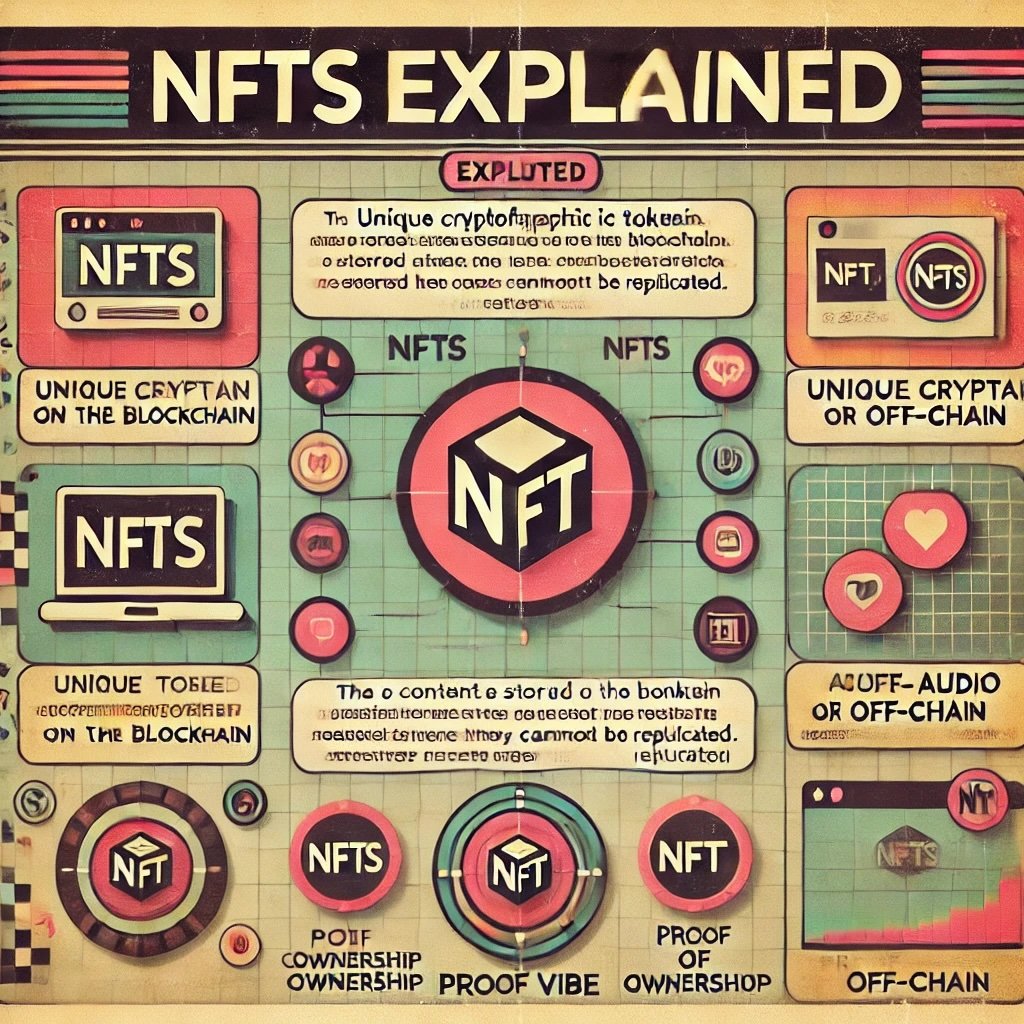
NFTs
Definition: A non-fungible token is a unique cryptographic token that cannot be replicated, ensuring that each NFT is one-of-a-kind or part of a limited edition minted on the blockchain. The actual “art” or “file” can be an image, GIF, video, audio track, or any digital content. The NFT itself is the proof of ownership, not the content. Typically, the content is stored either on-chain (if small enough) or off-chain, with the NFT referencing its location.
Characteristics:
- Programmability: Creators can embed royalty structures so each resale of the NFT automatically allocates a percentage back to the original artist.
- Instant Transferability: Ownership can shift from one user to another almost instantaneously, validated by the blockchain, reducing friction seen in traditional art auctions.
- Fractional Ownership: In theory, one can split an NFT into multiple tokens, letting multiple parties share ownership, though this is less common but increasingly explored.
Use Cases:
- Digital collectibles from generative art projects (e.g., CryptoPunks, Bored Ape Yacht Club).
- Digital expansions for gaming, virtual items or metaverse objects.
- Event tickets, domain names, or music rights.
Cultural Impact: Proponents argue that NFTs democratize art by removing gatekeepers (galleries, auction houses), allowing artists from anywhere to directly mint, sell, and get paid globally. However, critics see them as ephemeral or subject to fads, citing how some NFT prices soared and crashed in short cycles.
Traditional Artwork
Definition: Physical artifacts crafted by artists using mediums like oils, acrylics, marble, bronze, or any tangible material. The “art” is the object itself, existing in the physical realm. It can be displayed in a gallery, possessed in a private collection, or exhibited in a museum.
Characteristics:
- Materiality: Real surfaces, textures, brushstrokes, structural form. Viewing the original piece conveys an aura or authenticity that is intangible in digital duplicates.
- Historic and Cultural Legacy: Traditional art tracks centuries of aesthetic evolution—Renaissance, Impressionism, Modernism—carrying scholarly significance and deep cultural narratives.
- Uniqueness: Although forgeries exist, a genuine painting by a known master is inherently singular or part of a limited body of the artist’s life’s work. This can produce extraordinary valuations and reverence.
Use Cases:
- Display in personal living spaces or offices, public exhibitions, investment vehicles (some see high-end art as a store of value).
- Emotional or cultural resonance, linking to heritage, craftsmanship, or art history.
Cultural Impact: Traditional art has formed societies’ aesthetic dialogues, shaping how we interpret creativity, history, and identity. It’s deeply interwoven with institutions, from local galleries to premier auction houses like Sotheby’s or Christie’s.
Comparison Overview
One can see clear divergences in tangibility, technology usage, and cultural resonance. But similarities exist: both represent creative expression, can become objects of speculation or investment, and rely on intangible factors—like artist reputation or cultural significance—for much of their value. Some artists and collectors now even blend the two forms, creating physical pieces that tie to an NFT for authentication or combined experiences. This synergy underscores that NFTs and traditional art needn’t be mutually exclusive. They’re different approaches to what “art” and “ownership” can entail.
Both mediums reflect creativity, albeit in distinct ways.
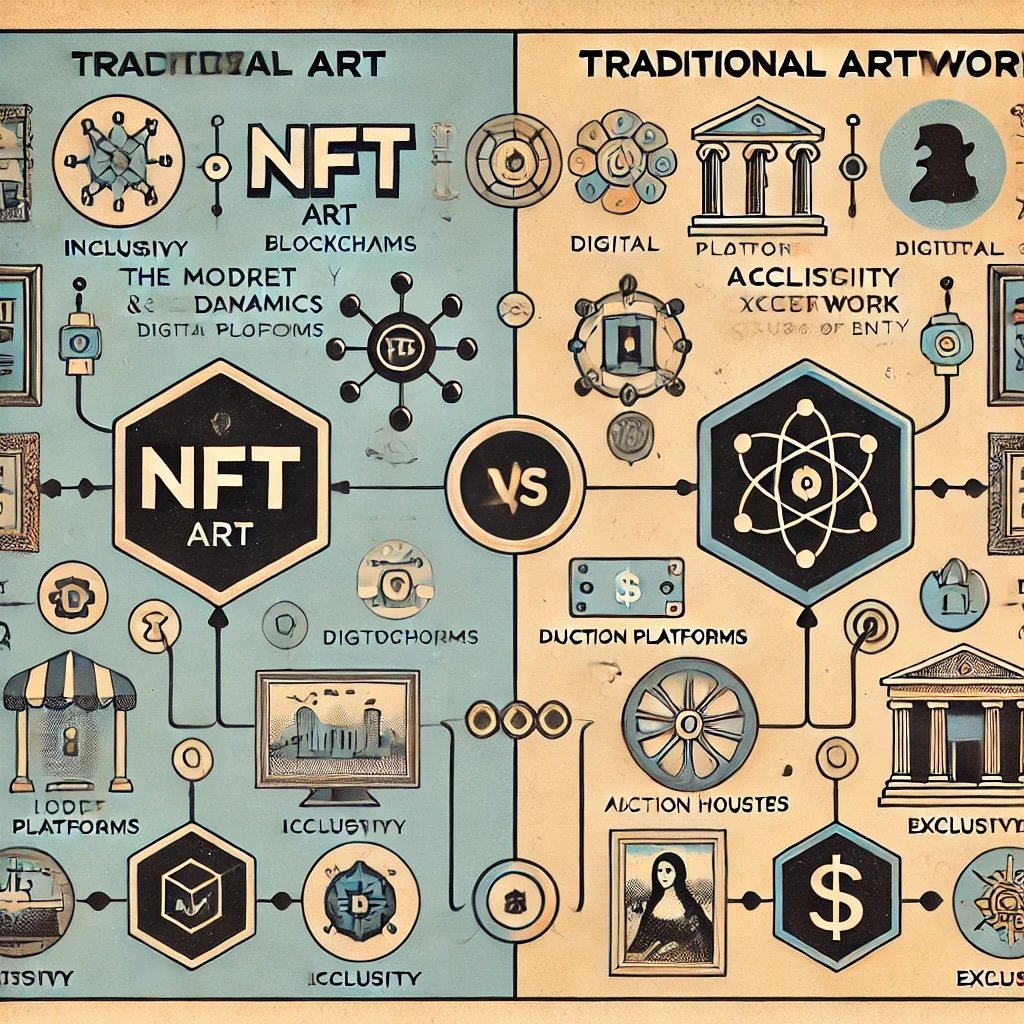
Market Dynamics and Accessibility
Both NFT art and traditional art exhibit unique market structures, shaped by historical precedent, cultural norms, and cutting-edge platforms. While certain parallels exist—like the presence of auctions or the influence of big players—there are also key differences in how easily creators and collectors can participate.
Two markets, two sets of dynamics.
NFT Market
Platforms and Marketplaces:
- OpenSea, Rarible, Foundation, Nifty Gateway: These web-based marketplaces serve as direct hubs where artists mint NFTs, and buyers can browse, bid, or purchase. They typically use cryptocurrencies (most commonly Ether on Ethereum).
- Low Entry Barrier: Any artist can mint NFTs relatively cheaply (though gas fees on certain blockchains can be high), and list them worldwide. This removes the gatekeeping function typical of galleries.
- Global Reach: A collector in Japan can buy an NFT from an artist in Brazil without any cross-border complexities besides crypto usage. Transactions settle quickly, and ownership updates instantly on-chain.
Accessibility for Creators:
- Anyone can participate: Freed from the need to court galleries or dealers, an emerging digital artist can mint their pieces.
- Crowded Space: Because of the low barrier, competition is intense. Thousands of NFT collections exist, making it challenging for lesser-known artists to stand out.
- Volatility and Hype: Some NFT projects see prices skyrocket overnight with mania, then crash days later. This can lead to big wins or painful losses for both creators and collectors.
Speculative Bubbles:
- Some argue that 2021’s NFT boom carried signs of an unsustainable frenzy, with “flippers” entering purely to buy and resell quickly for profit. This dynamic can overshadow genuine artistry.
- The market has proven cyclical, with periods of extreme hype followed by corrections.
NFT markets are open but can be chaotic.
Traditional Art Market
Auction Houses, Galleries, and Dealers:
- Christie’s, Sotheby’s: Prestigious auction houses that handle top-tier artwork, often commanding multi-million-dollar sales for iconic pieces.
- Galleries: Act as gatekeepers, curating which artists they represent, influencing tastes, and bridging artists with collectors.
- Private Dealers: Some high-end transactions happen privately, with no public record, especially for very expensive or rare works.
Accessibility:
- High Entry Barrier: Emerging artists often struggle to get their work displayed in established galleries. Collectors need significant capital to bid at top auctions.
- Exclusivity and Relationship Networks: Many deals happen through personal connections or an artist’s reputation. A newcomer cannot simply “upload” a piece to an auction.
- Regional and Cultural Ties: The traditional art world is deeply linked with cultural institutions, philanthropic societies, and historical prestige.
Speculation:
- Investment Approach: Some wealthy collectors treat art as an asset class, expecting appreciation over the years. Art funds have emerged, pooling capital to buy investment-grade works.
- Illiquidity: Selling a major painting can be time-consuming, reliant on a specialized auction or a collector willing to pay the demanded price.
- Counterfeiting and Forgery: A persistent risk, requiring experts and authenticity certificates.
Traditional art is valuable yet can be exclusive and slow-moving.
Bridging the Gap
An intriguing trend involves bridging these markets. Some galleries now partner with blockchain services to create digital twins of physical art, minted as NFTs for authentication or partial ownership. Similarly, digital-native artists sometimes produce physical prints or sculptures, forging a new hybrid realm. Over time, these crossovers might erode the boundaries, forging a more unified “art plus technology” landscape. However, many remain loyal to purely physical or purely digital mediums.
Cultural Tensions: Some in the traditional art world dismiss NFTs as ephemeral “click-and-save” phenomena. Meanwhile, NFT enthusiasts view the old art system as elitist, gate-kept, and archaic. The truth likely lies in a nuanced middle ground, with each approach offering strengths and weaknesses.
Markets evolve as the digital and physical worlds mingle.
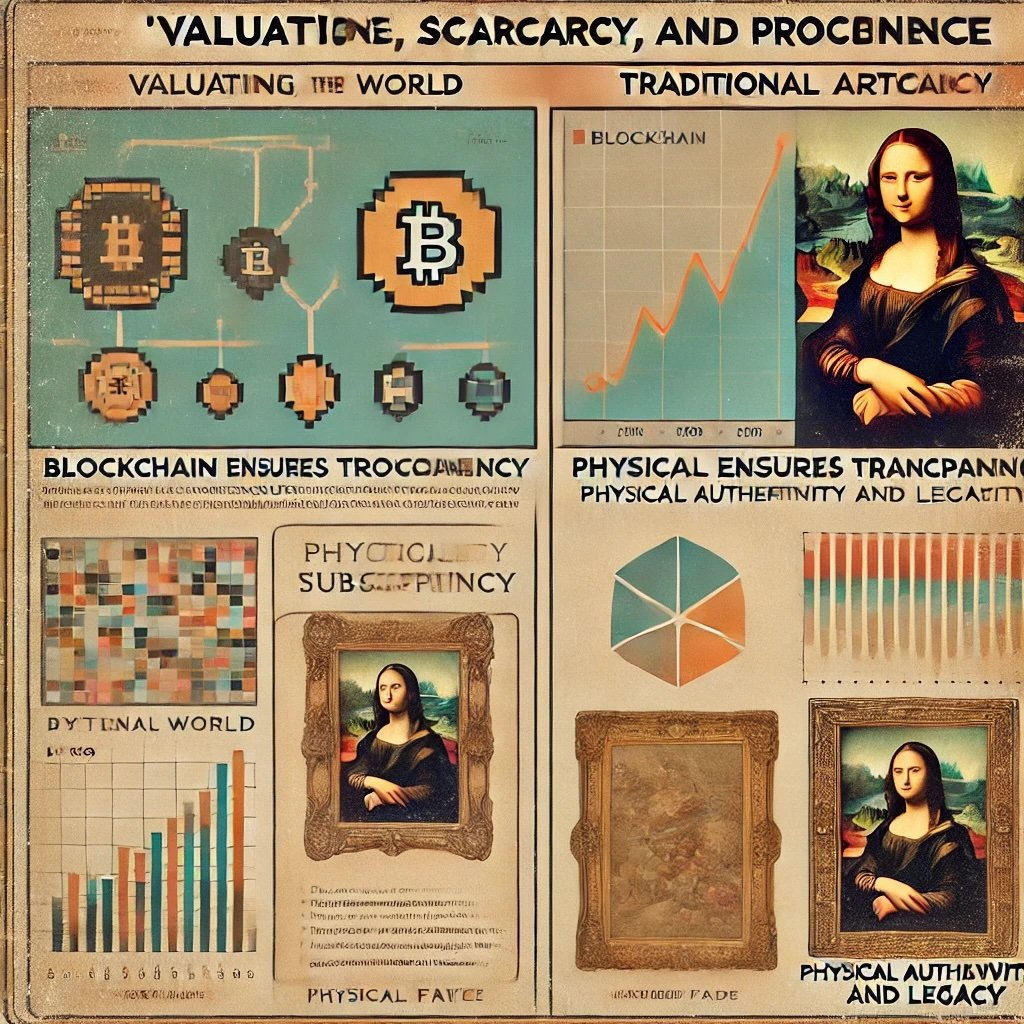
Valuation, Scarcity, and Provenance
Prices in art are notoriously subjective. Some items fetch millions at auction, even if an observer sees “just a splash of paint,” while other technically skilled works might remain cheap if there is no hype or recognized brand behind them. This pattern extends to NFTs as well, where certain digital collectibles command stratospheric sums. So, how do each approach handle valuation, scarcity, and provenance?
Value is never purely about cost of materials.
Valuation in NFTs
Market-Driven:
- The price of an NFT can skyrocket if there’s intense demand from collectors. Hype or celebrity endorsement can push a previously cheap piece to extraordinary heights.
- “Utility” or “community benefits” might raise prices. For instance, some NFT owners get access to exclusive events or membership privileges, which influences perceived value.
Creator Reputation:
- Well-known digital artists or influencers can mint NFTs that fetch large premiums because of brand recognition.
- The inherent risk is that new creators face difficulty standing out in a crowded field, so their NFTs might remain unsold or at low prices.
Volatility:
- Because NFTs are often purchased with cryptocurrencies (like Ether), price volatility is tied not just to the NFT’s desirability but also to crypto market swings.
- Bidding wars and short-lived fads can lead to huge peaks, followed by dramatic crashes.
Scarcity:
- Programmed Scarcity: NFTs can be minted in limited numbers or even as 1-of-1 unique pieces. This artificial but transparent scarcity fosters collectible appeal.
- Contrast with physical mediums, where the artist might produce more pieces in a similar style, but each is physically separate.
Software-level scarcity meets hype-driven demand.
Valuation in Traditional Art
Historical and Cultural Value:
- The price for a painting by Picasso or Van Gogh stems from their significance in art history, not just supply-and-demand mechanics. There’s an intangible aura of pedigree.
- Works with proven cultural impact or revolutionary style might command multi-million-dollar bids at auctions.
Artist Reputation:
- For living artists, strong gallery representation, critical acclaim, and proven sales histories can drive valuations up.
- Emerging artists might remain affordable until a major museum or influential curator spotlights their work.
Market Mechanisms:
- Auction house estimates, dealer negotiations, and private sales. Each transaction can set new price benchmarks.
- Less daily volatility than NFTs, but large leaps can occur if a piece breaks an auction record.
Scarcity:
- A painting or sculpture is physically unique. The idea that the artist’s hands crafted it in a specific moment or style fosters exclusivity.
- Reproductions (prints, lithographs) exist but are usually valued far less than the original. The intangible aspect of “the original piece” is huge in traditional art’s emotional and financial worth.
Provenance: Ensuring Authenticity
NFTs:
- The blockchain immutably records each transaction from the moment of minting. Checking an NFT’s contract address, transaction history, and the wallet that minted it can confirm authenticity.
- Frauds can occur if someone mints a piece they don’t own or plagiarizes an artist’s work. Yet the token itself is easily traceable, so verifying the official origin is simpler if the artist publicly identifies their official minting address.
Traditional Artwork:
- Typically requires certificates of authenticity, documentation from recognized experts or the artist’s estate, and a documented chain of ownership (provenance).
- Historically, forgeries have plagued the art world, necessitating advanced forensic analysis of paint, canvas, or style. Even then, some forgeries slip through.
Both systems have unique solutions to authenticity, each with vulnerabilities.
Challenges in Each System
- NFT Overhype: Some disclaim that many NFTs trade at inflated prices not backed by real creative value. A collapse in hype can render them near worthless.
- Traditional Art’s Elite Barriers: Some would-be collectors remain locked out by high costs, limited supply of top-tier art, and the opaque nature of private sales or auctions.
- Scams and Forgeries: The digital realm can host “copy-mints,” while physical art can see sophisticated fakes. Both rely on the buyer’s caution and expertise.
In summation, both NFTs and traditional art revolve around intangible values—whether cultural significance, historical context, brand, or hype. They differ in how that value is established, proven, and protected.
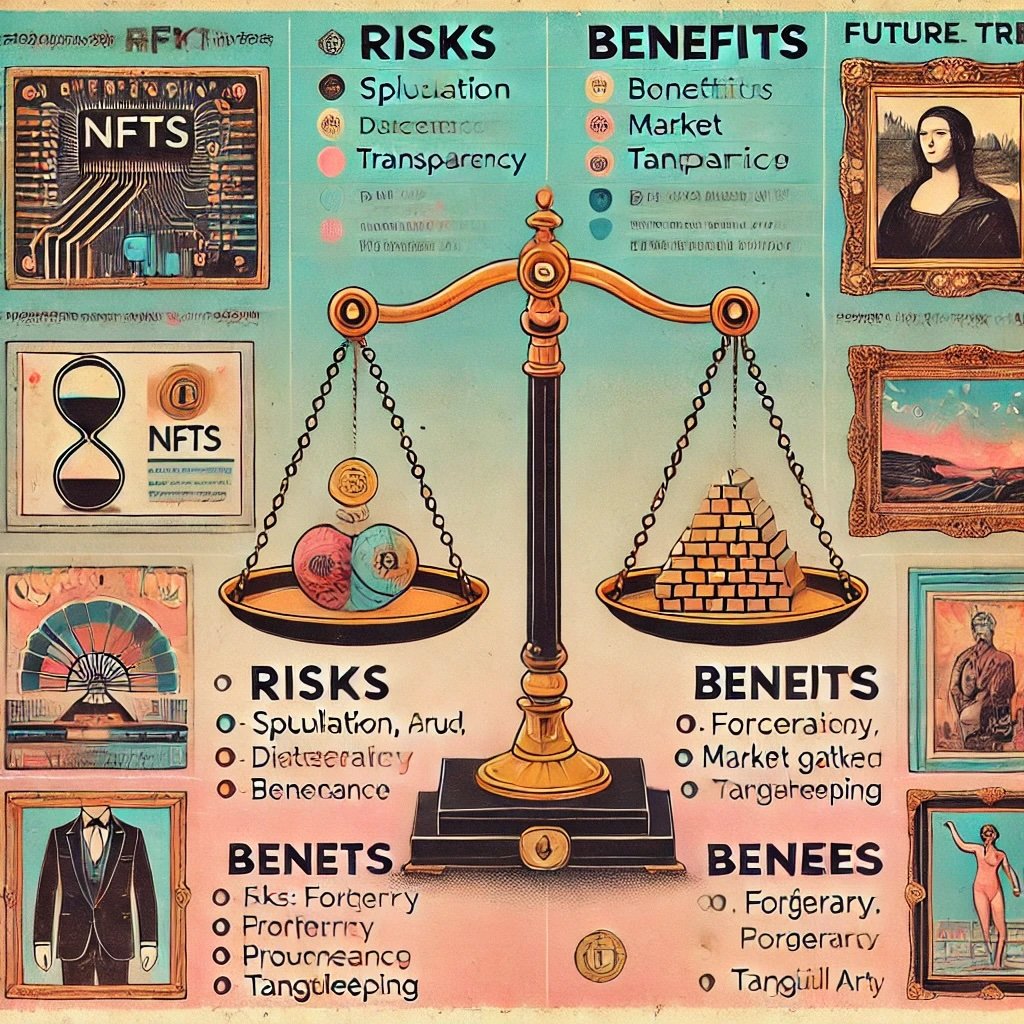
Risks, Benefits, and Future Trends
As with any investment or collectible pursuit, both NFTs and traditional artwork present trade-offs. Buyers must weigh risks, potential rewards, and the overarching direction each medium might follow. The digital revolution clearly reshapes how we conceive of ownership, while centuries-old art traditions anchor themselves in tangible heritage. Let’s break down the major risks, benefits, and future possibilities for both.
Every coin has two sides, including this.
Risks of NFTs
- Market Volatility: NFT values can swing wildly due to speculation, limited liquidity, or the roller-coaster nature of cryptocurrency markets. A piece might sell for $10,000 one day, only to garner $1,000 weeks later if the hype fades.
- Speculative Bubbles: The NFT market has seen phases reminiscent of mania, where lesser-known projects soared on social media hype, then collapsed. Many new NFT collections fail to hold value long-term, burdening latecomers with major losses.
- Regulatory Uncertainty: Governments globally still debate how to classify and tax NFTs. Sudden legal actions or regulatory frameworks could hamper the market or add complexities.
- Environmental Concerns: Certain blockchains use high energy-consuming consensus mechanisms (like proof of work). Critics argue that NFT minting and transactions contribute to carbon footprints unless offset by greener technologies.
Benefits of NFTs
- Direct Monetization for Artists: Digital creators, previously struggling with piracy or micro-earnings from platforms, can now directly sell unique tokens, often with automatic royalties on resales. This fosters a more artist-centered marketplace.
- Global Accessibility: Anyone with internet and crypto access can buy or sell NFTs, removing geographic barriers or conventional gatekeepers.
- Provenance and Transparency: On-chain records confirm ownership and transaction history, reducing some complexities of typical authentication methods used in the physical art world.
- Creative Innovation: Many NFT projects explore interactive or dynamic features, pushing the envelope of what “art” can be in digital domains.
Risks of Traditional Art
- Forgery and Theft: High-value pieces are prime targets for counterfeiters or thieves. Authenticating older works can be complex, requiring expert opinions. Even so, occasional forgeries slip through.
- High Transaction Costs: Auction house commissions can be substantial, sometimes exceeding 20%. Storage, insurance, and preservation add ongoing costs.
- Illiquidity: Selling a major painting can take months or longer. The art market is also less transparent, with private sales not always recorded, complicating price discovery.
- Elite Gatekeeping: Gaining access to top-tier works often demands existing relationships with galleries or large sums of money. For emerging collectors, the system might feel opaque.
Benefits of Traditional Art
- Tangibility and Heritage: Owning a physical piece you can display, admire, and share in-person carries emotional and aesthetic pleasure that digital replicas can’t replicate. Historical or cultural significance deepens that connection.
- Deeply Established Market: Auction houses and galleries have centuries of experience, lending an air of stability, though not immunity to cyclical ups and downs.
- Potential for Long-Term Appreciation: Many established artists or historical works hold their value or appreciate over time, especially if taste and scarcity support them.
- Cultural Cachet: For collectors, the prestige of owning a recognized painting or sculpture fosters intangible but real social capital, especially in certain circles.
Physical presence can be a potent emotional draw.
Future Trends
- Hybrid Models: Some projects now attach a physical artwork plus an NFT, bridging the digital and material realms. Buyers might receive a painting shipped to them, plus a token verifying digital or fractional ownership.
- Metaverse Galleries: As virtual environments grow, people may display NFT art in VR or AR-based galleries. Traditional art forms might also get digitized.
- Improved Eco-Friendliness: With the move to proof-of-stake or more efficient blockchains, the environmental critique of NFTs may lessen. This might open gates for more mainstream adoption.
- Art Worlds Converge: Traditional art institutions are dipping toes in NFTs. Auction houses like Sotheby’s have run NFT auctions. Conversely, NFT-based artists occasionally produce physical variants. Over time, the boundaries might dissolve, or a new normal emerges with both mediums accepted as legitimate, though distinct, forms of collectibility.
Expect more cross-pollination, less friction.
In sum, each medium offers distinct advantages and pitfalls. NFTs excel in accessibility, programmability, and digital innovation, yet remain vulnerable to hype cycles and environmental concerns. Traditional art stands on pillars of tangible heritage, proven track record, and cultural significance, but can be expensive, exclusive, and slow to transact. Where we go next is uncertain, but the synergy or tension between these worlds promises to reshape how we define art ownership in the years ahead.
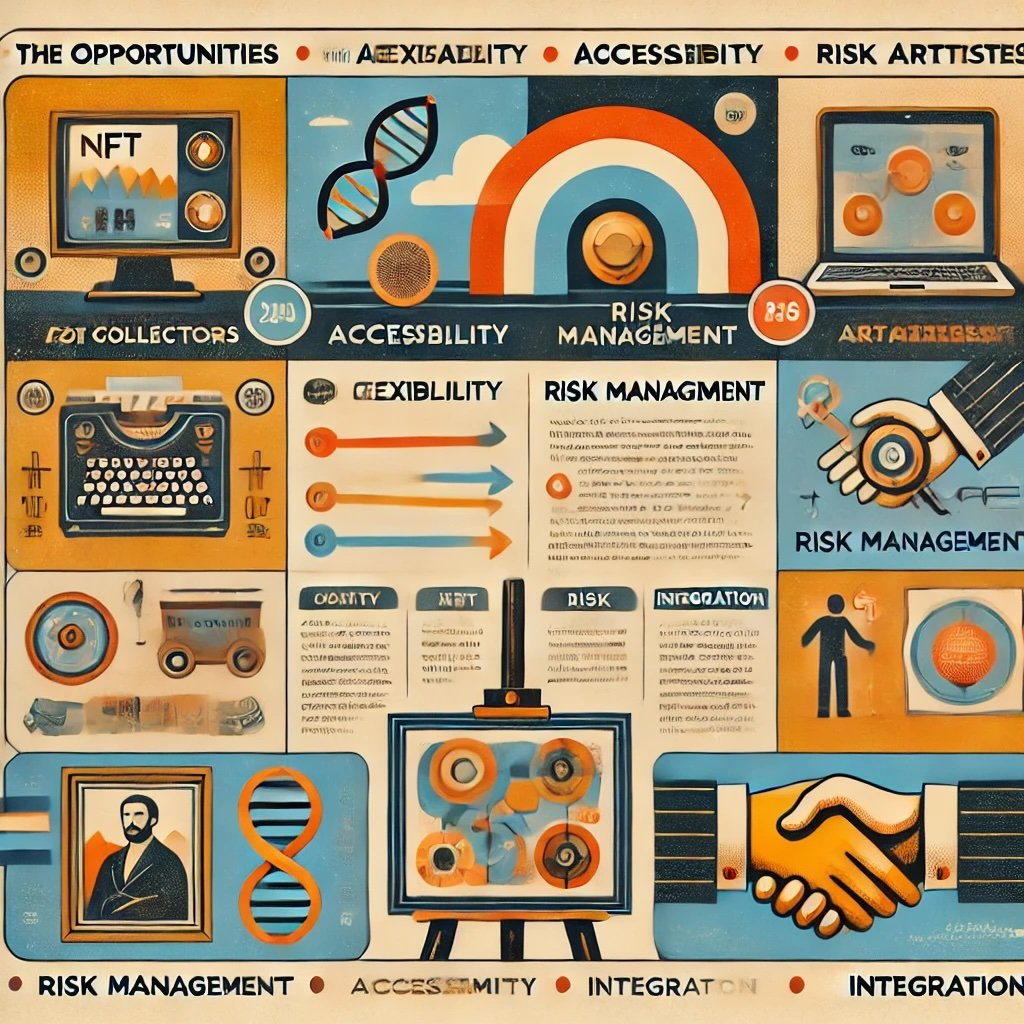
Conclusion
The art world stands at a fascinating crossroads, where NFT-based digital art rapidly emerges as a novel yet sometimes divisive phenomenon, while traditional art remains deeply entrenched with centuries of history, cultural cachet, and tangible presence. Both mediums exhibit unique selling points—NFTs boasting blockchain-driven authenticity and borderless access, and traditional art exuding physical beauty and historical prestige. However, both also grapple with challenges that can hamper their stable growth: speculation, fraud, or costly barriers in one form or another.
Each path has perils and promise.
Recap of Key Differences and Similarities
- NFTs revolve around digital tokens representing creative works. They feature easy transferability, on-chain provenance, and programmability for perpetual royalties. But they face scrutiny over volatility, hype, and environmental impact.
- Traditional Artwork is concrete and deeply tied to centuries of cultural tradition. Its value emerges from tangible uniqueness and historical importance. Yet, forging or verifying authenticity, illiquidity, and high entry barriers remain perennial concerns.
- Overlap: Both forms are driven by intangible factors—artist reputation, collector sentiment, and cultural narratives. Valuation is never purely rational but shaped by perceived significance, scarcity, and hype.
What Does This Mean for Collectors and Artists?
- Flexibility: Artists have expanded avenues—selling purely digital pieces via NFTs or retaining physical mediums. Some choose to do both, bridging fans across realms.
- Accessibility: New collectors might find NFTs a simpler entry point with fewer gatekeepers, albeit riskier due to speculation. Traditional collectors can explore new mediums without abandoning the charm of physical works.
- Risk Management: For potential investors or serious art collectors, due diligence remains paramount. In either domain, verify authenticity, consider the artist’s track record, and remain aware that hype-driven mania can distort real value.
- Integration: We’re likely to see more synergy—a painting with an associated NFT certificate, or NFT communities venturing into physical print releases. The boundary is softening.
Adapt and explore the best of both.
Final Thoughts
Rather than framing NFTs vs. Traditional Artwork as a battle to see which medium wins, a more constructive perspective is that they represent complementary dimensions of modern creativity. The intangible charm of the physical brushstroke isn’t diminished by the digital revolution, and the revolutionary aspects of NFTs—letting artists monetize globally, maintaining trackable ownership—shouldn’t be dismissed as mere hype. We’re witnessing an ongoing redefinition of art’s distribution, reception, and valuation. In some cases, technology can magnify the reach of artists, forging entirely new collector bases who’ve never stepped foot in an auction house or gallery. In others, the time-tested rituals of museum exhibits, in-person art fairs, and the intangible allure of gazing upon a physical masterpiece continue to flourish.
So, for those curious about collecting or investing: dive in with eyes open. If digital tokens excite you, research thoroughly, follow legitimate artists or collections, and watch out for speculative mania. If physical art remains your passion, relish its tangibility but remain aware that new digital frontiers might reshape how art ownership is perceived. The new collectible landscape is broader and more diverse than ever, with digital frontiers and classical traditions coexisting—each offering a window into humanity’s ever-evolving drive for creative expression.
Important Information
Comprehensive Investment Disclaimer:
All content provided on this website (including but not limited to portfolio ideas, fund analyses, investment strategies, commentary on market conditions, and discussions regarding leverage) is strictly for educational, informational, and illustrative purposes only. The information does not constitute financial, investment, tax, accounting, or legal advice. Opinions, strategies, and ideas presented herein represent personal perspectives, are based on independent research and publicly available information, and do not necessarily reflect the views or official positions of any third-party organizations, institutions, or affiliates.
Investing in financial markets inherently carries substantial risks, including but not limited to market volatility, economic uncertainties, geopolitical developments, and liquidity risks. You must be fully aware that there is always the potential for partial or total loss of your principal investment. Additionally, the use of leverage or leveraged financial products significantly increases risk exposure by amplifying both potential gains and potential losses, and thus is not appropriate or advisable for all investors. Using leverage may result in losing more than your initial invested capital, incurring margin calls, experiencing substantial interest costs, or suffering severe financial distress.
Past performance indicators, including historical data, backtesting results, and hypothetical scenarios, should never be viewed as guarantees or reliable predictions of future performance. Any examples provided are purely hypothetical and intended only for illustration purposes. Performance benchmarks, such as market indexes mentioned on this site, are theoretical and are not directly investable. While diligent efforts are made to provide accurate and current information, “Picture Perfect Portfolios” does not warrant, represent, or guarantee the accuracy, completeness, or timeliness of any information provided. Errors, inaccuracies, or outdated information may exist.
Users of this website are strongly encouraged to independently verify all information, conduct comprehensive research and due diligence, and engage with qualified financial, investment, tax, or legal professionals before making any investment or financial decisions. The responsibility for making informed investment decisions rests entirely with the individual. “Picture Perfect Portfolios” explicitly disclaims all liability for any direct, indirect, incidental, special, consequential, or other losses or damages incurred, financial or otherwise, arising out of reliance upon, or use of, any content or information presented on this website.
By accessing, reading, and utilizing the content on this website, you expressly acknowledge, understand, accept, and agree to abide by these terms and conditions. Please consult the full and detailed disclaimer available elsewhere on this website for further clarification and additional important disclosures. Read the complete disclaimer here.

